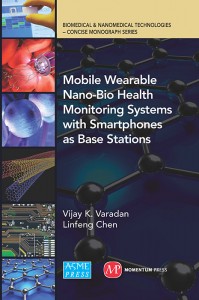 The University of Arkansas team that developed the "e-bra" – a remote monitoring system embedded in the fabric of base layers – has big plans for unobtrusive, wearable sensing technology. Think products that can replace expensive, inconvenient diagnostic testing and even predict heart attack and stroke.
The University of Arkansas team that developed the "e-bra" – a remote monitoring system embedded in the fabric of base layers – has big plans for unobtrusive, wearable sensing technology. Think products that can replace expensive, inconvenient diagnostic testing and even predict heart attack and stroke.
The team, led by neurosurgeon Dr. Vijay Varadan, distinguished professor of electrical engineering at the Fayetteville, Ark., school, and research scientist Linfeng Chen, has woven sensors into pillowcases and sheets so patients at sleep clinics don't need to be wired up, have their heads shaven or even have patches stuck to their skin. "You can sleep in any position you want," Varadan explains to MobiHealthNews.
Right now, the system, featuring six sensors in the pillowcase to track brain activity and six more in the sheet for measuring vital signs, is about 90 percent accurate. "We're working to improve that," Varadan says.
Varadan and Chen just published the first of about 10 volumes they plan on contributing to an American Society of Mechanical Engineers series of highly technical manuals on wireless health sensors. This book focuses on the history of textile-based sensors, health monitoring systems and mobile healthcare applications.
Two of the future volumes will look at sleep disorders and calorie burn rates to help determine the optimal mix of exercise for amateur and professional athletes. Others will examine the connection between brain and heart functioning in many medical ailments, according to Varadan, who directs Arkansas' High Density Electronics Center and the Center for Wireless Nano-, Bio- and Info-Tech Sensors and Systems. "When your brain is happy, your heart is happy," Varadan explains.
Wearable sensors potentially can pick up many of the signs of heart and brain disease that otherwise would require costly, uncomfortable imaging. "You can measure with a garment so you don't need to go to the hospital for an MRI," Varadan says. "You can do it at home."
Or the testing can be performed during everyday activities, as the e-bra sports bra for women and vest for men does, rather than in a lab when the patient might not be in a natural situation. "Through your daily activities, you are not relaxing," Varadan explains. Textile sensors pick up vital signs as people go about their lives.
Like the University of Southern California's Center for Body Computing, the Arkansas researchers have tested wireless sensors on football players and other athletes. But Varadan takes the concept one step farther, putting monitors not just in undershirts, but in helmets for capturing brain waves during actual game action. "Right now, they do prescreening with the sticky stuff [patches]," Varadan says.
Inverted T-waves, which Varadan says are somewhat common in wide receivers, raise the risk for heart attack, severe angina and even death, according to published research. Varadan also notes that there has been little published research from physicians on neurogenic T-waves, an abnormality that he says can predict the onset of a stroke up to six months in advance.
Varajan indicates that he is looking into setting up a company to market smart fabrics and garments, some of which even have embedded GSM transmitters that work over cellular network. However, he has not been able to find a U.S.-based manufacturer, which he prefers. "Every textile [he is working with now] is made in China or India," he says.
The Arkansas researchers have applied for patents and Food and Drug Administration clearance on some of their innovations, including the sensor-laden sheets. Varadan also has applications pending for implantable devices that not only stimulate the brain of people with Parkinson's and Alzheimer's diseases, they can measure the effectiveness of such treatments.
















